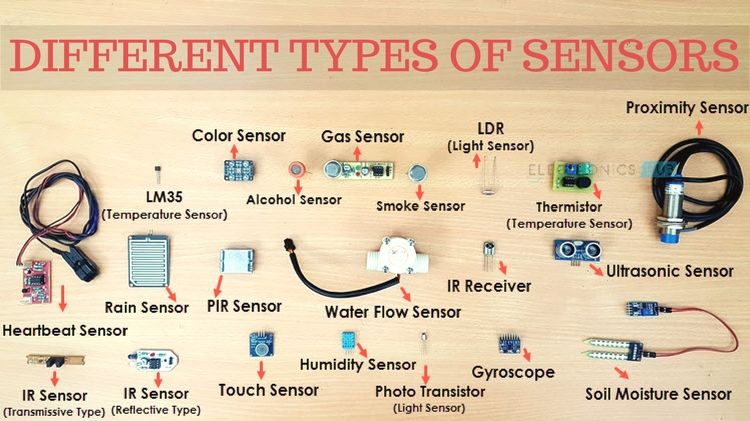Sensor | Types of Sensors
Sensor
Below figure is of a thermocouple.
Note that a transducer and sensor is not same. In the above given example of thermocouple. The thermocouple acts as a transducer but the additional circuits or components needed like the voltmeter, a display etc together from a temperature sensor. Hence the transducer will just convert the energy from one form to another and all the remaining work is done by the additional circuits connected. This whole device forms a sensor. Sensors and transducers are closely related to each other.
A sensor’s sensitivity indicates how much the sensor’s output changes when the input quantity being measured changes. For instance, if the mercury in a thermometer moves 1 cm when the temperature changes by 1 °C, the sensitivity is 1 cm/°C
Characteristics of Sensors
A good sensor should have the following characteristics
- High Sensitivity: Sensitivity indicates how much the output of the device changes with unit change in input (quantity to be measured). For example the voltage of a temperature sensor changes by 1mV for every 1oC change in temperature than the sensitivity of the sensor is said to be 1mV/oC.
- Linearity: The output should change linearly with the input.
- High Resolution: Resolution is the smallest change in the input that the device can detect.
- Range : Every sensor has a range in which they work with an acceptable error. If the input is not in range, then the output is unpredictable.
- Drift :The signal level varies for the same input over a long period; this is called as drift. The drift will cause an error in the measured value. The drift may result from aging of the sensor or temperature variance.
- Hysteresis :The hysteresis is the characteristic of a sensor by which the sensor produces a different set of outputs if the data is recorded in different directions (increasing input or decreasing input).
- Calibration : If a meaningful measurement is to be made, it is necessary to tune the output of the sensor with accurately known input.
- Precision : The precision of a sensor is its ability to produce same output when repeatedly measured for the same input. The precision is determined using statistical analysis standard deviation.
- Accuracy : The accuracy of a sensor defines how close the output is to the real value. The accuracy defines the maximum error the sensor may produce.
- Less Noise and Disturbance.
- Less power consumption.
Types of Sensors
Sensors are classified based on the nature of quantity they measure. Following are the types of sensors with few examples.
Sensor classification
(1) Based on the quantity being measured
- Temperature: Resistance Temperature Detector (RTD), Thermistor, Thermocouple
- Pressure: Bourdon tube, manometer, diaphragms, pressure gauge
- Force/ torque: Strain gauge, load cell
- Speed/ position: Tachometer, encoder, LVDT
- Light: Photo-diode, Light dependent resistor
- Proximity Sensor,
- Ultrasonic Sensor
- Smoke, Gas and Alcohol Sensor
- Touch Sensor
- Color Sensor
- Humidity Sensor
And so on.
(2) Active and passive sensors: Based on power requirement sensors can be classified as active and passive. Active sensors are those which do not require external power source for their functioning. They generate power within themselves to operate and hence called as self-generating type. The energy for functioning is derived from the quantity being measured.
For example piezoelectric crystal generate electrical output (charge) when subjected to acceleration. Passive sensors require external power source for their functioning. Most of the resistive, inductive and capacitive sensors are passive (just as resistors, inductors and capacitors are called passive devices).
(3) Analog and digital sensor: An analog sensor converts the physical quantity being measured to analog form (continuous in time). Thermocouple, RTD, Strain gauge are called analog sensors. A digital sensor produces output in the form of pulse. Encoders are example of digital sensors.
(4) Inverse sensors: There are some sensors which are capable of sensing a physical quantity to convert it to other form and also sense the output signal form to get back the quantity in original form. For example a piezoelectric crystal when subjected to vibration generates voltage. At the same time when a piezo – crystal is subjected to varying voltage they begin to vibrate. This property make them suitable to use in microphone and speakers.
ArticleSource : BootCampLab ; electrical4u
ImageSource : Electronics Hub
Read Also :
Types of Thermocouples
Resistance Temperature Detector

